Dual-Path Adversarial Generation Network for Super-Resolution Reconstruction of Remote Sensing Images
Abstract
1. Introduction
2. The Related Work
3. The Proposed Network Model
3.1. Generator Structure
3.2. Discriminator Structure
3.3. Network Training
- (1)
- Initialize program parameters, and access the training datasets.
- (2)
- Input the low-resolution images in the generator network, and reconstruct the high-resolution images through the dual-path module.
- (3)
- Calculate and save the PSNR, the SSIM, and the running time.
- (4)
- Compare the output results with the corresponding ground-truth HR to calculate the loss function in the discriminator network.
- (5)
- If the discriminator result is FALSE, then update the weight parameter by backpropagation, and return to step (2).
- (6)
- If the discriminator result is FALSE, then judge whether the loss function is convergent. If it is not convergent, optimize the discriminator. If it is, return to step (2).
- (7)
- Obtain the optimized generator and discriminator network model.
4. Experiments and Comparisons
4.1. Experimental Hardware Configuration
4.2. Experimental Comparison
4.3. Experimental Analysis
5. Conclusions
Author Contributions
Funding
Informed Consent Statement
Data Availability Statement
Acknowledgments
Conflicts of Interest
References
- Temenos, A.; Temenos, N.; Doulamis, A.; Doulamis, N. On the Exploration of Automatic Building Extraction from RGB Satellite Images Using Deep Learning Architectures Based on U-Net. Technologies 2022, 10, 19. [Google Scholar] [CrossRef]
- Chen, X. Design of Political Online Teaching Based on Artificial Speech Recognition and Deep Learning. Comput. Intell. Neurosci. 2022, 2022, 3112092. [Google Scholar] [CrossRef] [PubMed]
- Lewis, W. AI Image Recognition Technology Based on Face and Expression Recognition. J. Res. Sci. Eng. 2022, 4, 98–103. [Google Scholar] [CrossRef]
- Dong, C.; Loy, C.C.; He, K.; Tang, X. Learning a deep convolutional network for image super-resolution. In Proceedings of the European Conference on Computer Vision, Zurich, Switzerland, 6–12 September 2014; Springer: Cham, Switzerland, 2014; pp. 184–199. [Google Scholar]
- Dong, C.; Loy, C.C.; Tang, X. Accelerating the super-resolution convolutional neural network. In Proceedings of the European Conference on Computer Vision, Amsterdam, The Netherlands, 11–14 October 2016; Springer: Cham, Switzerland, 2016; pp. 391–407. [Google Scholar]
- Kim, J.; Kwon Lee, J.; Mu Lee, K. Accurate image super-resolution using very deep convolutional net-works. In Proceedings of the IEEE Conference on Computer Vision and Pattern Recognition, Las Vegas, NV, USA, 27–30 June 2016; pp. 1646–1654. [Google Scholar]
- Lim, B.; Son, S.; Kim, H.; Nah, S.; Mu Lee, K. Enhanced Deep Residual Networks for Single Image Super-Resolution. In Proceedings of the IEEE Conference on Computer Vision and Pattern Recognition, Honolulu, HI, USA, 21–26 July 2017. [Google Scholar]
- Lai, W.S.; Huang, J.B.; Ahuja, N.; Yang, M.H. Deep Laplacian pyramid networks for fast and accurate super-resolution. In Proceedings of the IEEE Conference on Computer Vision and Pattern Recognition, Honolulu, HI, USA, 21–26 July 2017; pp. 624–632. [Google Scholar]
- Ledig, C.; Theis, L.; Huszár, F.; Caballero, J.; Cunningham, A.; Acosta, A.; Shi, W. Photo-realistic single image super-resolution using a generative adversarial network. In Proceedings of the 2017 IEEE Conference on Computer Vision and Pattern Recognition, Honolulu, HI, USA, 21–26 July 2017; pp. 4681–4690. [Google Scholar]
- Shi, W.; Caballero, J.; Ledig, C.; Zhuang, X.; Bai, W.; Bhatia, K.; Rueckert, D. Cardiac image super-resolution with global correspondence using multi-atlas patchmatch. In Proceedings of the International Conference on Medical Image Computing and Computer-Assisted Intervention, Nagoya, Japan, 22–26 September 2013; pp. 9–16. [Google Scholar]
- Lian, L.; Lei, T. Film and Television Animation Sensing and Visual Image by Computer Digital Image Technology. J. Math. 2022, 2022, 6331233. [Google Scholar] [CrossRef]
- Huang, B.; He, B.; Wu, L.; Guo, Z. Deep Residual Dual-Attention Network for Super-Resolution Reconstruction of Remote Sensing Images. Remote Sens. 2021, 13, 2784. [Google Scholar] [CrossRef]
- He, X.-G.; Wu, X.-M.; Wang, L.; Liang, Q.-Y.; Gu, L.-J.; Liu, F.; Lu, H.-L.; Zhang, Y.; Zhang, M. Distributed optical fiber acoustic sensor for in situ monitoring of marine natural gas hydrate production for the first time in the Shenhu area, China. China Geol. 2022, 5, 322–329. [Google Scholar] [CrossRef]
- Zhang, Y.; Tian, Y.; Kong, Y.; Zhong, B.; Fu, Y. Residual dense network for image super-resolution. In Proceedings of the 2018 IEEE/CVF Conference on Computer Vision and Pattern Recognition, Salt Lake City, UT, USA, 18–23 June 2018; pp. 2472–2481. [Google Scholar]
- Kim, J.; Lee, J.K.; Lee, K.M. Deeply-recursive convolutional network for image super-resolution. In Proceedings of the IEEE Conference on Computer Vision and Pattern Recognition, Las Vegas, NV, USA, 27–30 June 2016; pp. 1637–1645. [Google Scholar]
- Muhammad, U.; Wang, W.; Chattha, S.P.; Ali, S. Pre-trained VGGNet Architecture for Remote-Sensing Image Scene Classification. In Proceedings of the 24th International Conference on Pattern Recognition (ICPR), Beijing, China, 20–24 August 2018. [Google Scholar] [CrossRef]
- Zhang, Y.; Li, K.; Li, K.; Wang, L.; Zhong, B.; Fu, Y. Image super-resolution using very deep residual channel attention net-works. In Proceedings of the European Conference on Computer Vision, Munich, Germany, 8–14 September 2018; pp. 286–301. [Google Scholar]
- Zhang, P.; Lam, E.Y. From Local to Global: Efficient Dual Attention Mechanism for Single Image Super-Resolution. IEEE Access 2021, 9, 114957–114964. [Google Scholar] [CrossRef]
- Wang, X.; Yi, J.; Guo, J.; Song, Y.; Lyu, J.; Xu, J.; Yan, W.; Zhao, J.; Cai, Q.; Min, H. A Review of Image Super-Resolution Approaches Based on Deep Learning and Applications in Remote Sensing. Remote Sens. 2022, 14, 5423. [Google Scholar] [CrossRef]
- Moustafa, M.S.; Ebied, H.M.; Helmy, A.K.; Nazamy, T.M.; Tolba, M.F. Acceleration of super-resolution for multispectral images using self-example learning and sparse representation. Comput. Electr. Eng. 2017, 62, 249–265. [Google Scholar] [CrossRef]
- Wang, P.; Bayram, B.; Sertel, E. A comprehensive review on deep learning based remote sensing image super-resolution methods. Earth-Sci. Rev. 2022, 232, 104110. [Google Scholar] [CrossRef]
- Yang, X.; Xie, T.; Liu, L.; Zhou, D. Image super-resolution reconstruction based on improved Dirac residual network. Multidimens. Syst. Signal Process. 2021, 32, 1065–1082. [Google Scholar] [CrossRef]
- Esmaeilzehi, A.; Ahmad, M.O.; Swamy, M.N.S. A Deep Light-Weight Network for Single Image Super Resolution Using Spatial and Spectral Information. IEEE Trans. Comput. 2021, 7, 409–421. [Google Scholar] [CrossRef]
- Wang, Y.; Perazzi, F.; McWilliams, B.; Sorkine-Hornung, A.; Sorkine-Hornung, O.; Schroers, C. A fully pro-gressive approach to single-image super-resolution. In Proceedings of the IEEE Conference on Computer Vision and Pattern Recognition (CVPR), Salt Lake City, UT, USA, 18–23 June 2018; pp. 977–986. [Google Scholar]
- Srivastava, R.K.; Greff, K.; Schmidhuber, J. Training very deep networks. Adv. Neural Inf. Process. Syst. 2015, 28, 2377–2385. [Google Scholar]
- Chen, Y.; Liu, L.; Phonevilay, V.; Gu, K.; Xia, R.; Xie, J.; Zhang, Q.; Yang, K. Image super-resolution reconstruction based on feature map attention mechanism. Appl. Intell. 2021, 51, 4367–4380. [Google Scholar] [CrossRef]
- Soh, J.W.; Cho, S.; Cho, N.I. Meta-transfer learning for zero-shot super-resolution. In Proceedings of the IEEE Conference on Computer Vision and Pattern Recognition (CVPR), Seattle, WA, USA, 13–19 June 2020; pp. 3513–3522. [Google Scholar]
- Ren, Z.; Zhao, J.; Wang, C.; Ma, X.; Lou, Y.; Wang, P. Research on Key Technologies of Super-Resolution Reconstruction of Medium and Long Wave Maritime Infrared Image. Appl. Sci. 2022, 12, 10871. [Google Scholar] [CrossRef]
- Ren, Z.; Zhao, J.; Chen, C.; Lou, Y.; Ma, X.; Tao, P. Rendered image super-resolution reconstruction with multi-channel feature network. Sci. Program. 2022, 2022, 9393589. [Google Scholar] [CrossRef]
- Wang, Z.; Bovik, A.C.; Sheikh, H.R.; Simoncelli, E.P. Image quality assessment from error visibility to structural similarity. IEEE Trans. Image Process. 2004, 13, 600–612. [Google Scholar] [CrossRef] [PubMed]
- Sheikh, H.R.; Bovik, A.C.; de Veciana, G. An information fidelity criterion for image quality assessment using natural scene statistics. IEEE Trans. Image Process. 2005, 14, 2117–2128. [Google Scholar] [CrossRef] [PubMed]
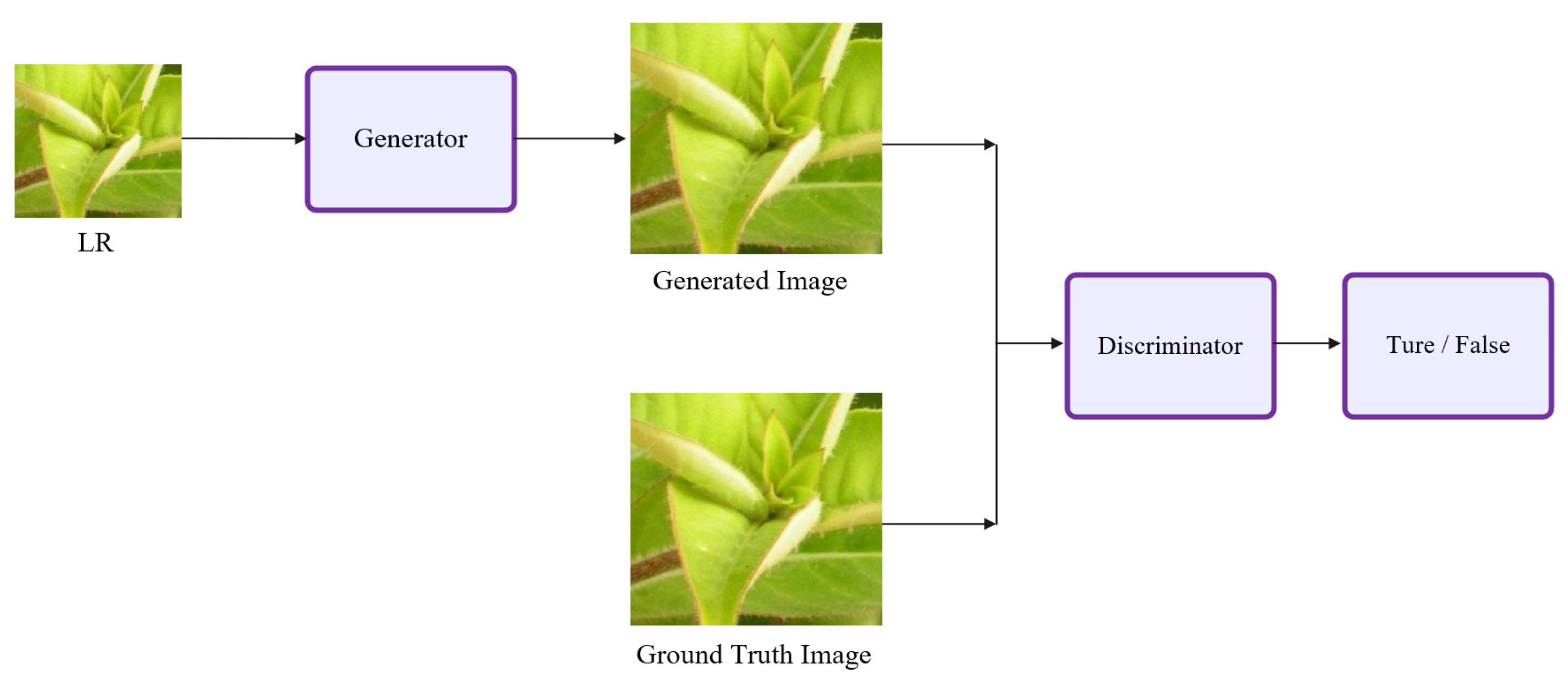

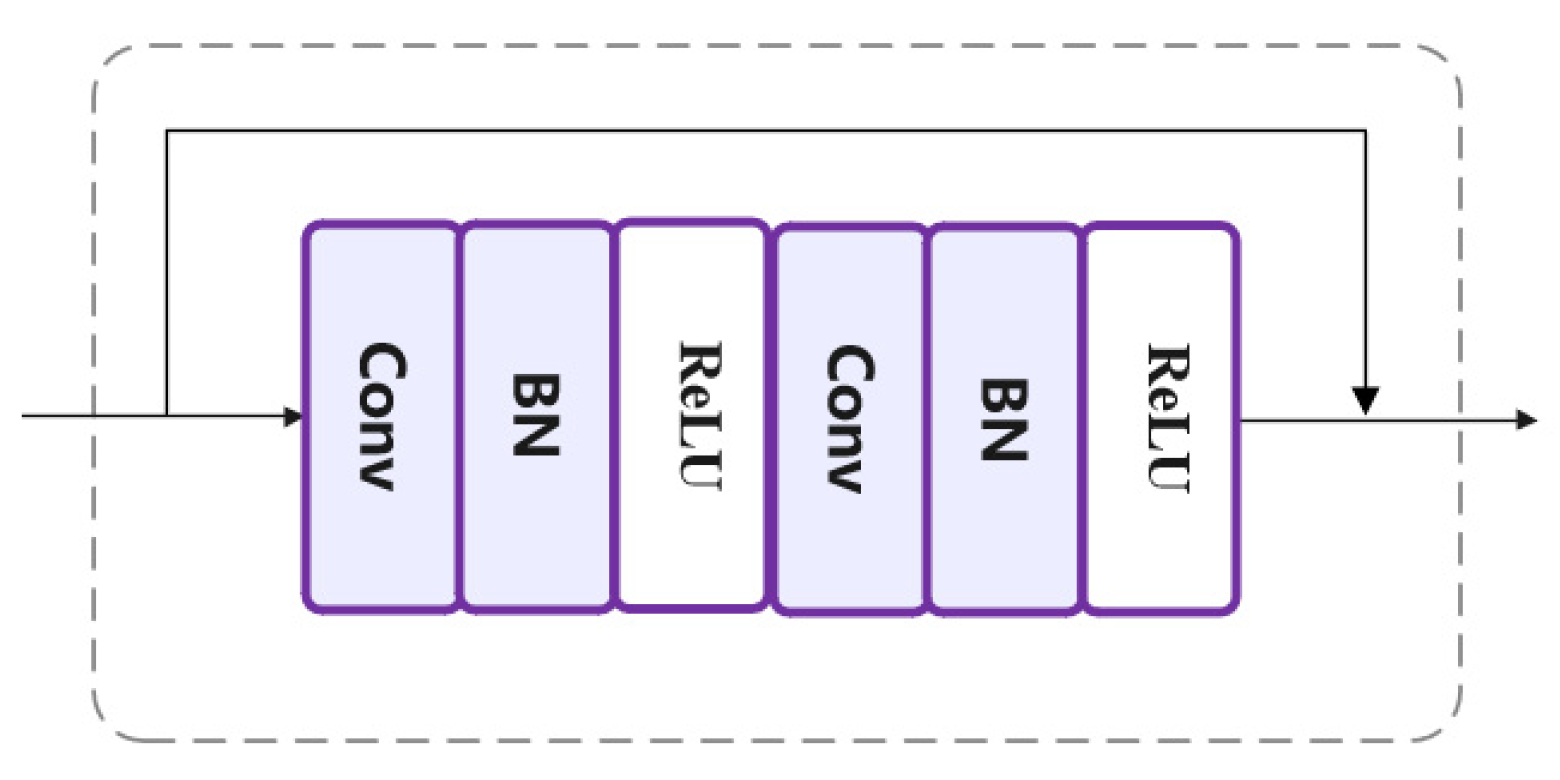






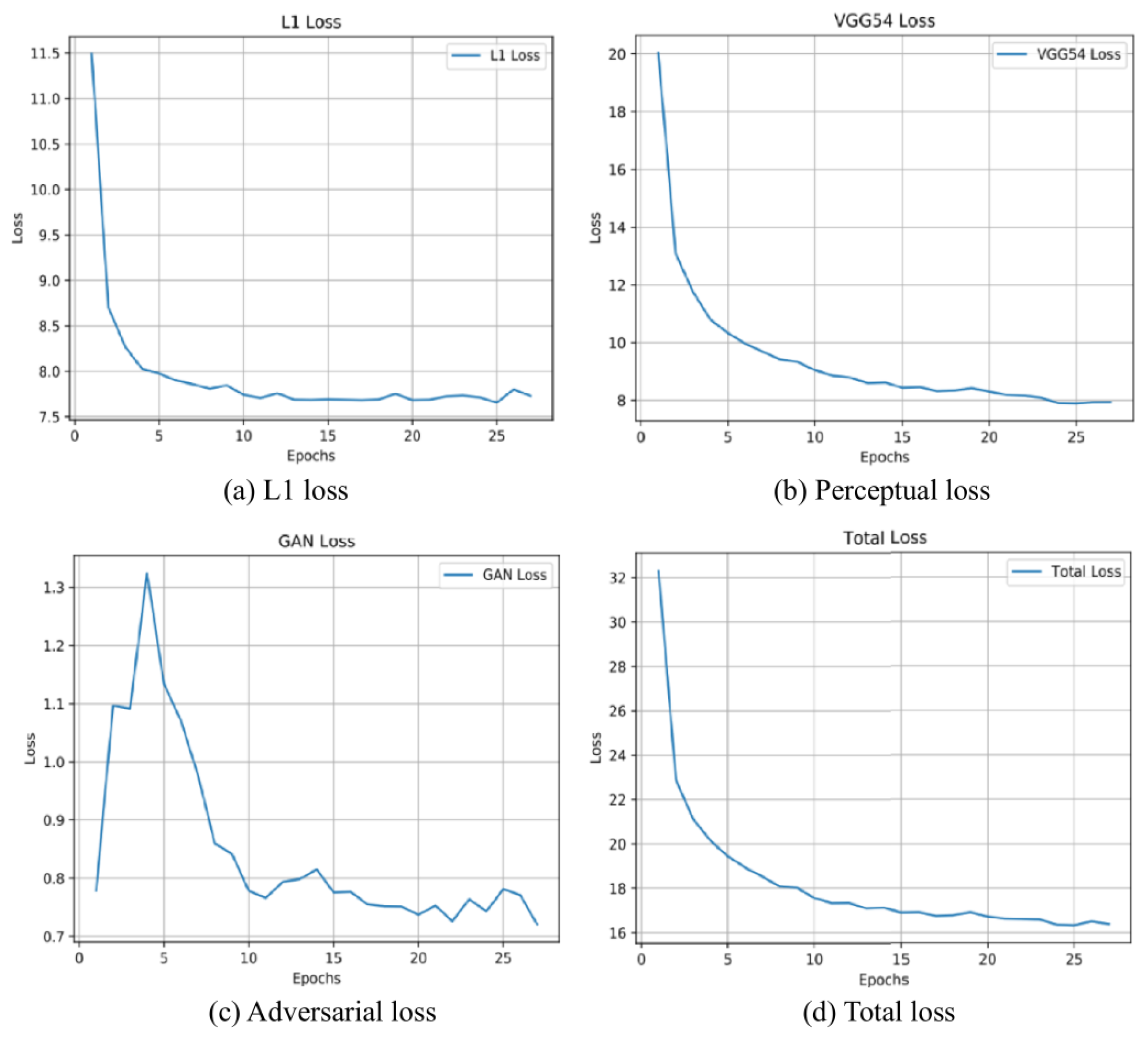

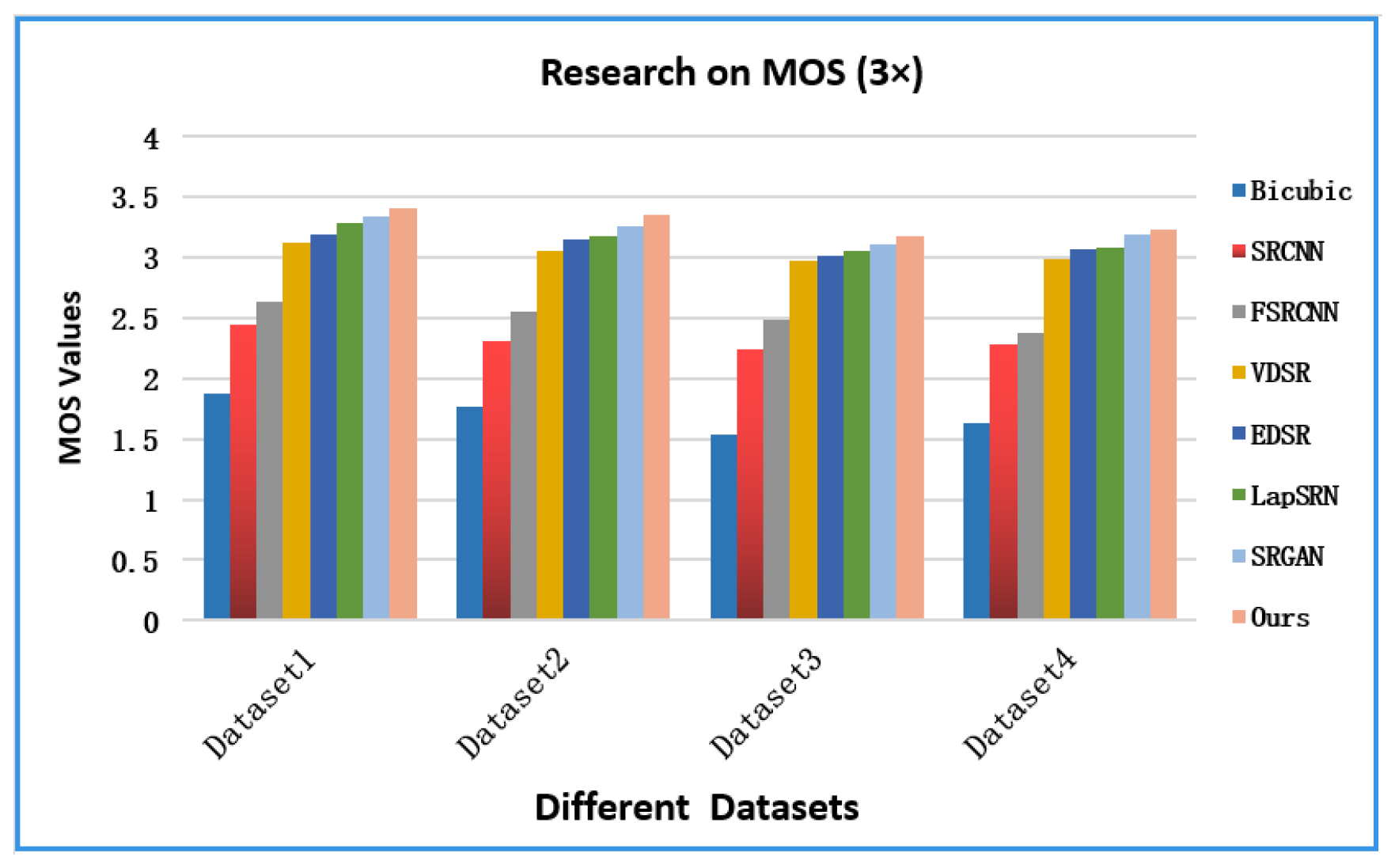
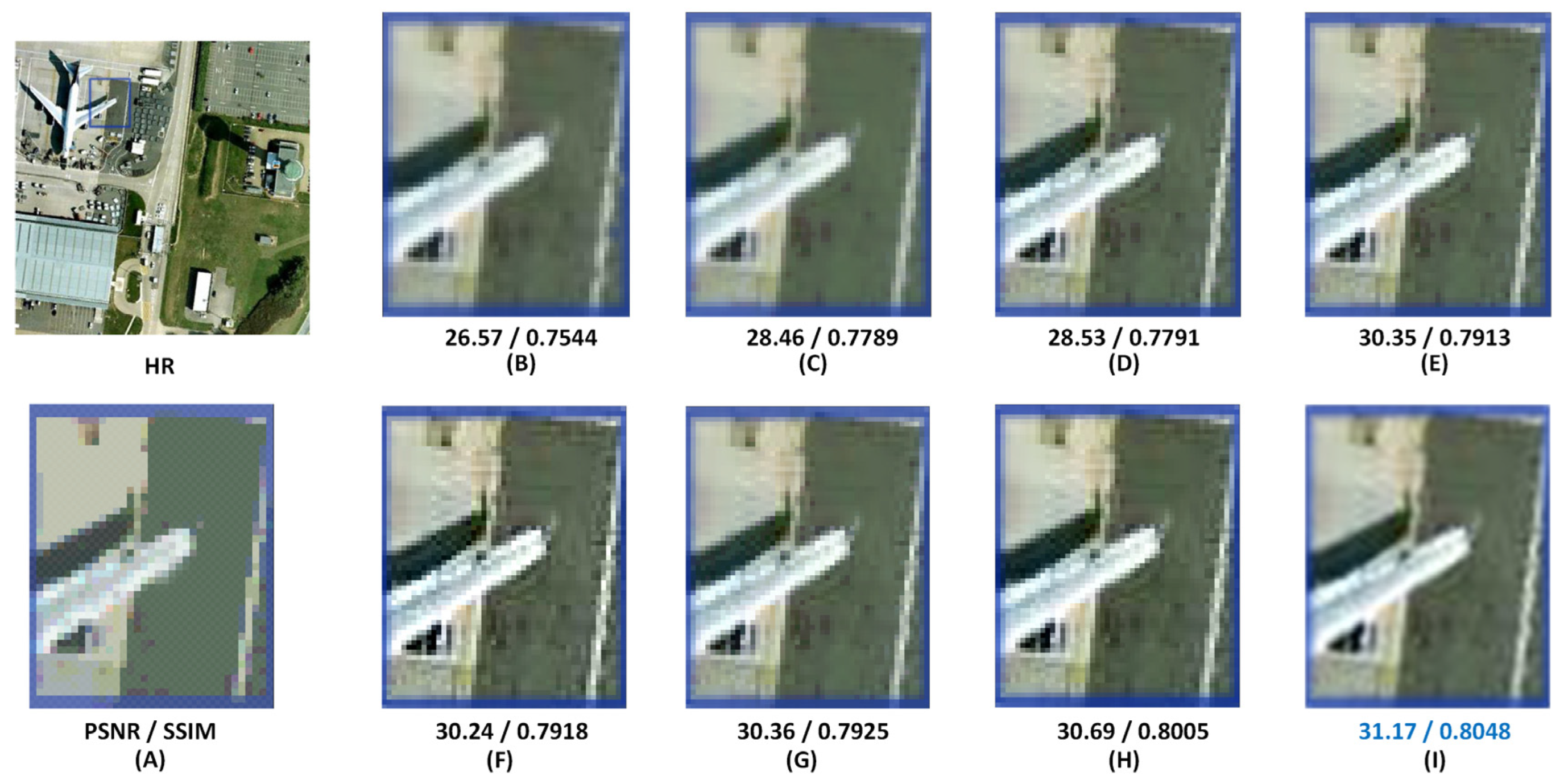
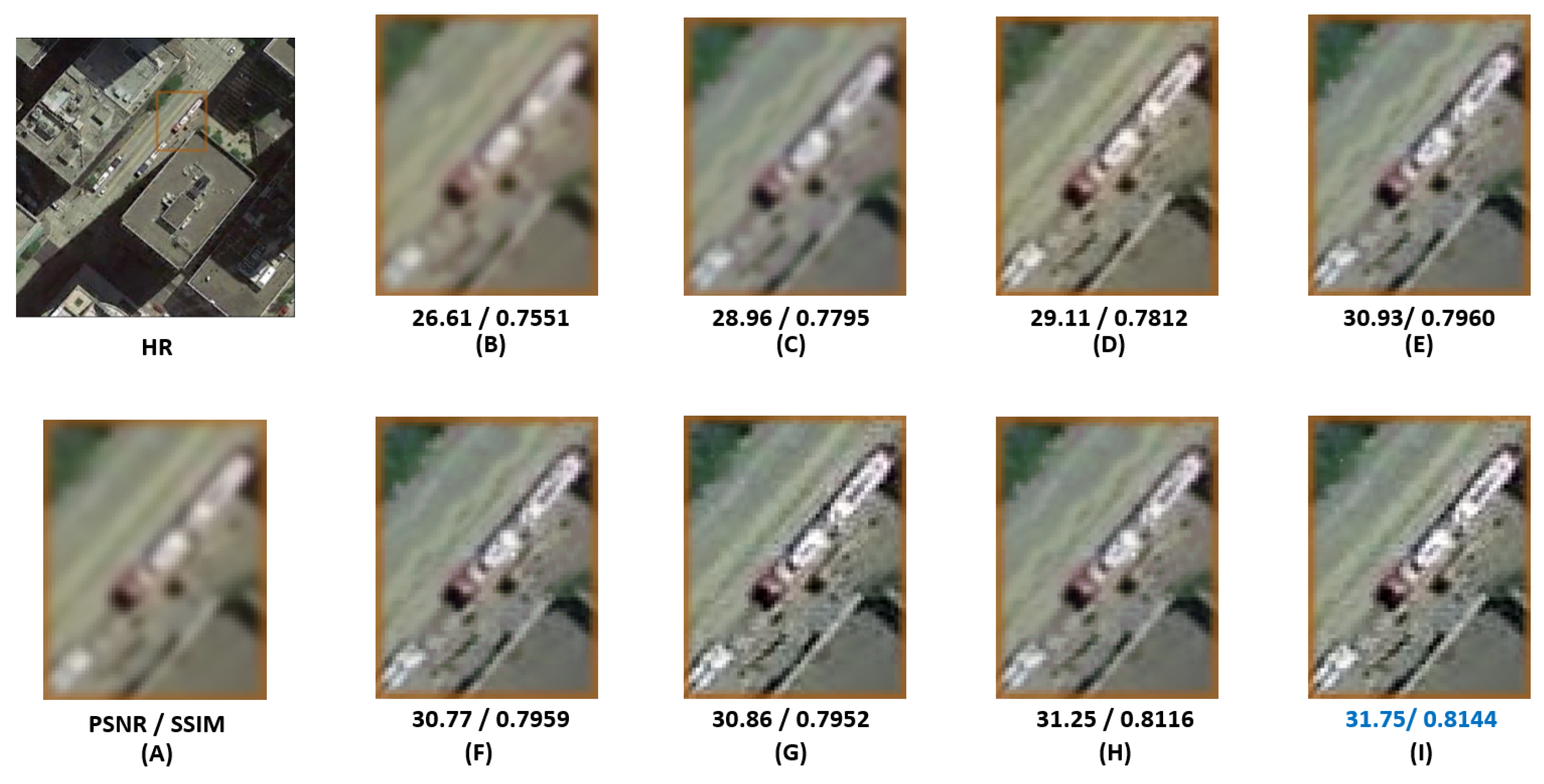
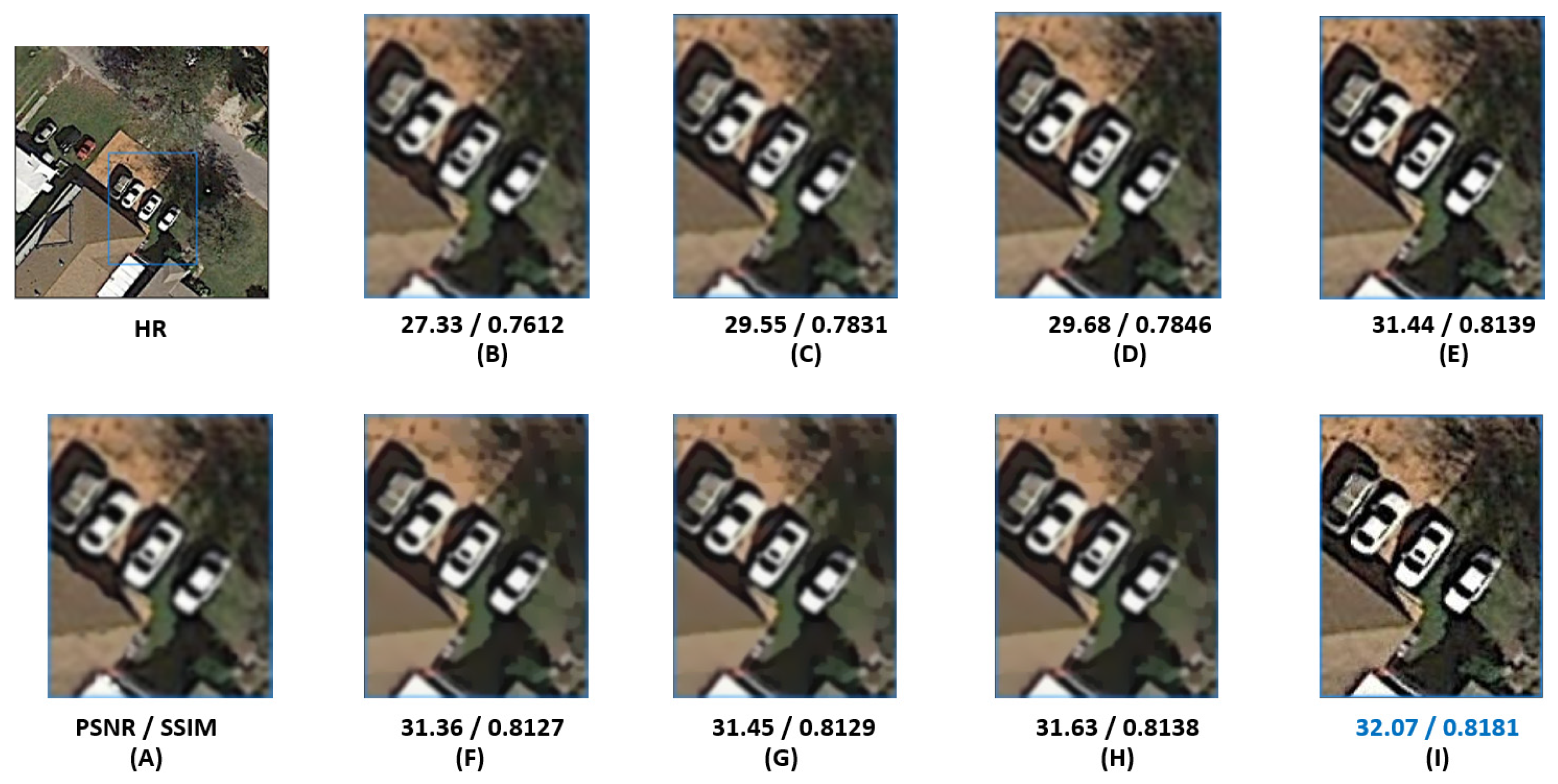
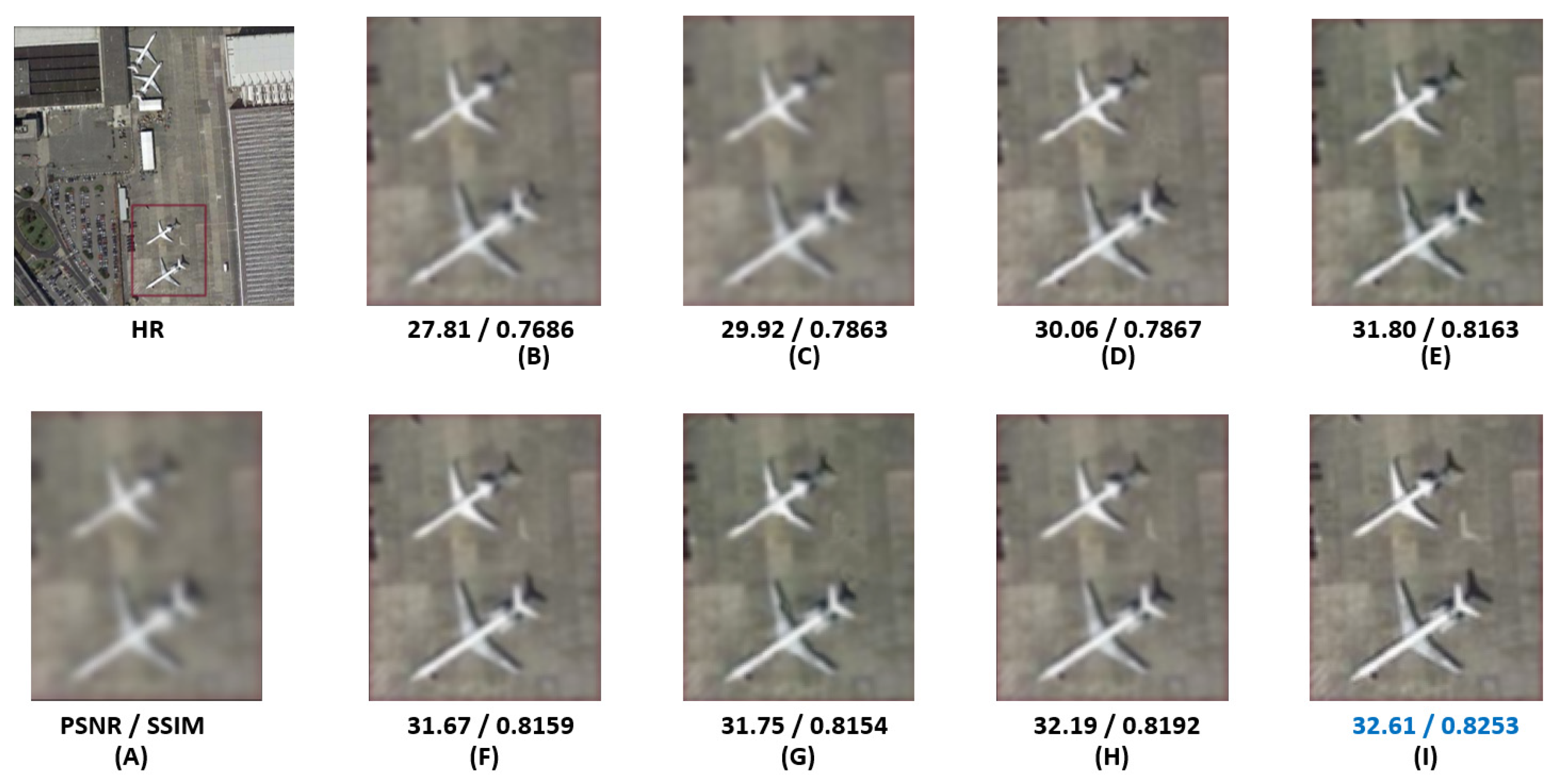
| Algorithm | Input | Reconstruction | Depth | Filters | Parameters | Residual Structure | Loss | Training Time |
|---|---|---|---|---|---|---|---|---|
| SRCNN | LR + bicubic | Direct | 3 | 64 | 57 K | No | L2 | 75 h |
| FSRCNN | LR | Direct | 8 | 56 | 12 K | No | L2 | 46 h |
| VDSR | LR + bicubic | Direct | 20 | 64 | 665 K | Yes | L2 | 4 h |
| MDSR | LR | Direct | 162 | 64 | 8000 K | Yes | Charbonnier | 160 h |
| LapSRN | LR | Progressive | 24 | 64 | 812 K | Yes | Charbonnier | 72 h |
| Dataset | Scale | Bicubic | SRCNN | FSRCNN | VDSR | EDSR | LapSRN | SRGAN | Ours |
|---|---|---|---|---|---|---|---|---|---|
| Dataset 1 | 3× | 26.54 | 28.43 | 28.56 | 30.37 | 30.23 | 30.34 | 30.70 | 31.15 |
| Dataset 2 | 3× | 26.59 | 28.98 | 29.10 | 30.91 | 30.76 | 30.87 | 31.26 | 31.72 |
| Dataset 3 | 3× | 27.36 | 29.52 | 29.66 | 31.47 | 31.32 | 31.43 | 31.61 | 32.06 |
| Dataset 4 | 3× | 27.83 | 29.91 | 30.04 | 31.82 | 31.65 | 31.77 | 32.18 | 32.64 |
| Dataset | Scale | Bicubic | SRCNN | FSRCNN | VDSR | EDSR | LapSRN | SRGAN | Ours |
|---|---|---|---|---|---|---|---|---|---|
| Dataset 1 | 3× | 0.7543 | 0.7781 | 0.7792 | 0.7912 | 0.7915 | 0.7913 | 0.8002 | 0.8034 |
| Dataset 2 | 3× | 0.7549 | 0.7795 | 0.7813 | 0.7959 | 0.7957 | 0.7953 | 0.8114 | 0.8142 |
| Dataset 3 | 3× | 0.7615 | 0.7836 | 0.7847 | 0.8134 | 0.8129 | 0.8126 | 0.8137 | 0.8179 |
| Dataset 4 | 3× | 0.7687 | 0.7859 | 0.7866 | 0.8165 | 0.8158 | 0.8157 | 0.8189 | 0.8255 |
| Dataset | Scale | Bicubic | SRCNN | FSRCNN | VDSR | EDSR | LapSRN | SRGAN | Ours |
|---|---|---|---|---|---|---|---|---|---|
| Dataset1 | 3× | 1.88 | 2.45 | 2.63 | 3.12 | 3.19 | 3.28 | 3.34 | 3.41 |
| Dataset2 | 3× | 1.76 | 2.31 | 2.55 | 3.06 | 3.15 | 3.17 | 3.26 | 3.35 |
| Dataset3 | 3× | 1.53 | 2.24 | 2.48 | 2.97 | 3.01 | 3.06 | 3.11 | 3.17 |
| Dataset4 | 3× | 1.63 | 2.28 | 2.37 | 2.99 | 3.07 | 3.08 | 3.19 | 3.23 |
Disclaimer/Publisher’s Note: The statements, opinions and data contained in all publications are solely those of the individual author(s) and contributor(s) and not of MDPI and/or the editor(s). MDPI and/or the editor(s) disclaim responsibility for any injury to people or property resulting from any ideas, methods, instructions or products referred to in the content. |
© 2023 by the authors. Licensee MDPI, Basel, Switzerland. This article is an open access article distributed under the terms and conditions of the Creative Commons Attribution (CC BY) license (https://creativecommons.org/licenses/by/4.0/).
Share and Cite
Ren, Z.; Zhao, J.; Chen, C.; Lou, Y.; Ma, X. Dual-Path Adversarial Generation Network for Super-Resolution Reconstruction of Remote Sensing Images. Appl. Sci. 2023, 13, 1245. https://doi.org/10.3390/app13031245
Ren Z, Zhao J, Chen C, Lou Y, Ma X. Dual-Path Adversarial Generation Network for Super-Resolution Reconstruction of Remote Sensing Images. Applied Sciences. 2023; 13(3):1245. https://doi.org/10.3390/app13031245
Chicago/Turabian StyleRen, Zhipeng, Jianping Zhao, Chunyi Chen, Yan Lou, and Xiaocong Ma. 2023. "Dual-Path Adversarial Generation Network for Super-Resolution Reconstruction of Remote Sensing Images" Applied Sciences 13, no. 3: 1245. https://doi.org/10.3390/app13031245
APA StyleRen, Z., Zhao, J., Chen, C., Lou, Y., & Ma, X. (2023). Dual-Path Adversarial Generation Network for Super-Resolution Reconstruction of Remote Sensing Images. Applied Sciences, 13(3), 1245. https://doi.org/10.3390/app13031245






